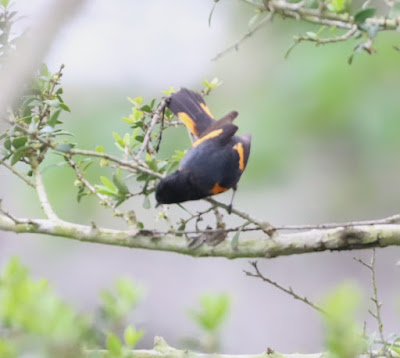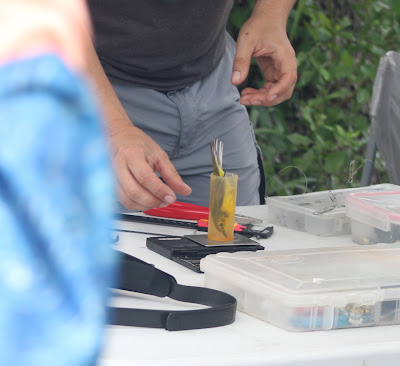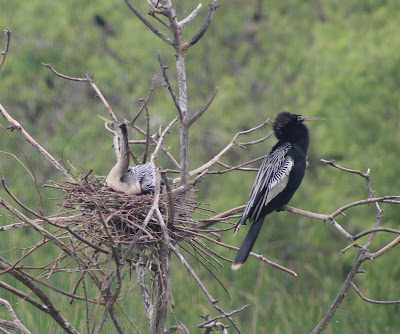Friday, April 28, 2023
Crossing Togwotee pass and the long drive to GTNP and Hamilton, Montana
We left Grand Isle, Louisiana and started a five day marathon drive to Grand Teton National Park and then Hamilton, Montana. Last year we hit it just right and got great pictures of Grizzly 399 and her four cubs. Now if the snow would just melt.
Our plan was to make it in four days and we did, by having two long days of driving over five hundred miles. Spending the last night in Dubois, Wyoming we headed over Togwotee Pass for Grand Teton National Park. The roads were at first dry but soon there was quite a bit of snow and by the time we reached Togwotee Pass the roads were slick and snow covered.
The amount of snow, on the sides of the road were in some places over six feet deep. The orange plastic piece is attached to the metal reflectors so the snowplow drivers can see the edge of the pavement. Our Subaru worked fine, we do have Michelin Mud and Snow tires on it, and the only spooky part was when we started sliding on a downhill stretch. The car quickly recovered, and it was really just a minor skid.
Reaching the park we saw snow, deep snow everywhere. Jackson Lake was frozen! The entire park was snow covered, with the exception of the Elk Refuge. We never saw a set of tracks and the only animals we saw were several moose and elk, feeding on the refuge.
Canceling our plans to spend several days in Jackson, we instead drove to Idaho Falls. From there we drove a new route through Big Hole, Montana and on to our Jen and Erics place in Hamilton Montana. Our plan is to spend eight days here and then to head back to Wyoming. Now if it will only heat up and melt the snow so our rv park can reopen for the season…….
By the way we ended up driving about 3047 miles before reaching Hamilton. That is farther than the drive to Anchorage Alaska.
Clear skies
Sunday, April 23, 2023
The Grand Isle Bird Fest of 2023
We arrived in Grand Isle, Louisiana, to find a place that was quite a bit different than normal The ditches and ponds were dry. It had not rained in a months, and we feared that the migrating birds would pass by the island. Added to the drought a strong south wind would allow the birds to reach the mainland.
The weather forecast changed and several days later it rained. Not as much as we had hoped for but at least some of the birds were feeding in the pond. As the annual Bird Festival drew near several strong fronts caused the wind direction to change and with this heavy rain along with coastal flooding filled the ditches. A magnificent frigate bird flew directly overhead but the light was bad, and I only got a poor image of it.
The locals call them rain birds and true to it’s name, it rained that night in windblown sheets. The wind was so strong that the water seeped around the window frames, and we had to place towels on and below the window ledges. It wasn’t as strong as the derecho from three years ago, but it was close as the wind speed was clocked at seventy-ix miles per hour.
Along with the added moisture, which soaked the ground, the strong winds blew down trees, including mulberry trees which were laden with unripe fruit.The fallout arrived in several waves. Where we had rarely seen any birds, we now spotted numerous indigo buntings, and blue grosbeaks.
Besides these two blue birds, a rose breasted grosbeak, and scarlet and summer tanagers posed for pictures along with a black and white warbler that fed on insects as it hopped from branch to branch on a dead tree. The rains also brought on the sudden appearance of resurrection ferns, and overnight, new fern fronds sprouted full grown. They appear on the large limbs of Southern Live Oak trees, (and almost as quickly retreat).
We did catch a glimpse of a cerulean warbler, but it did not pose long enough for a picture. An American redstart also teased us as we tried to get its image.When the birds are in the trees we must use manual focus or else the camera will focus on the leaves and branches. As a result we took over one thousand images to get about thirty good ones, (a great one is when we actually catch the fine plumage and the reflection in the birds eye). Finally a white eyed vireo gave us a perfect pose, along with a female summer tanager.
A common tern flew overhead and hooded warblers were everywhere. We also saw Cape May Warblers and while we were told a Prothonotary warbler had been spotted we never did see it. One of the final images was of an orchard oriole but we couldn't get a clear shot.It was a great week of birding and we also had quality family time with my sister Connie and her husband Gary and my nephew Blains new wife, Mari. She has a great smile and lights up all with her great attitude.
We were blessed to see so many birds, Thanks again Connie and Gary, for the blessings of so many good times! Clear skies
Wednesday, April 19, 2023
The Audubon Society's Bird Banding during the 2023 Grand Isle Bird Festival
Each year we try to attend the Grand Isle Bird Fest. It’s usually around the middle of April and often coincides with a fallout. A fallout of birds happens when the birds migrate north across the Gulf of Mexico and run into a strong cold front. The north winds tire the birds and they, “Fall out”, on the first Island or land they reach.
There they feed voraciously, regaining their strength before continuing their northward migration. At this year’s bird fest, a strong fallout occurred. In conjunction with the bird fest the Audubon Society, with Federal Permits, conducted a bird banding operation. The Audubon Society, puts out mist nets which are almost invisible to the birds. They fly into them and usually get entangled, allowing one to carefully capture them and place them in a sack for study and banding. (at one time twenty bird sacks were waiting for the researcher)!
The nets are constantly checked, and the birds quickly placed in bags and then delivered by a runner to the tagging area, (at one time twenty bird sacks were waiting for the researcher)! There they are identified and weighed, by placing them in an open plastic pill bottle, The are also measured for length and age by blowing on their feathers to study the maturity of the bird.
They are finally leg banded with a seven or eight digit number and then released unharmed.It was really amazing to watch bird experts conduct the trapping and tagging. On the first day 97 birds were captured, including four painted buntings. Renita and I were passing by when one male bunting flew into the net!
It was amazing to watch the study as it was happening! Thanks Renita for taking such great pictures of the banding operation. Clear skies
Thursday, April 13, 2023
Smith Oaks Forest, Dons Drip, and another trail along Smiths Pond
After lunch we decided to take the trail to Nicole’s Niche and Dons Drip. Driving to another parking lot we would be closer, but it ended up being a waste of time as we could have easily reached them both from our lunch spot near the Rookery.
Last year at Dons Drip we become involved in a birding controversy as a warbler had been misidentified. I wrote about it and won’t repeat the story here). This year we did not see any birds using the drip and we had the place to ourselves.
Continuing along the leaf covered trail, to Nicole’s Niche, I kept a constant lookout for birds and snakes. Not seeing any I walked to the drip, a place where water has been piped to form a bird bath and a bird sip. I noticed movement next to my foot I saw a four-foot-long snake threatening to bite me. I had almost stepped on it, and Renita was so close to it that I said “Lookout, snake!”. She screamed, loudly I might add, and then jumped in the safe direction. She had almost stepped on it! So much for spotting any birds. I reminded her that one must be quiet to see birds or bears, (I will not repeat what she said as she also gave me the look)!
The snake rattled its tail, but it was only mimicking a rattlesnake. We later identified it as a Texas Rat snake. They can and will bite but this one only threatened. If you blow up the picture you can see its eye is round not catlike, which is indicative of all non-poisonous snakes.
Last year at Dons Drip we had been involved in a birding controversy as a warbler had been misidentified. I wrote about it and won’t repeat the story here). This year we did not see any birds using the drip and we had the place to ourselves.
Walking the other trails, we photographed a rosette spoonbill flying bye and passed an alligator trail where it crossed the path from one pond to another. Keeping an eye out for its snout we wanted to make sure we didn’t end up as lunch, but we never spotted it.
Renita spied a female anhinga across the pond and took a good photograph of it as it perched and dried it’s wings. On the way back to the car I saw a resting water moccasin floating next to the trail. It ignored us and I tried to take its picture, but I forgot to use the manual focus and the camera focused on some nearby grass. Darn it.
It had been a great day, it always is at High Island. The Houston Audubon Society does an excellent job maintaining the eight birding sites. Well done Houston! Now it’s on to Grand Isle, Louisiana where family and more birds await! Clear skies
Tuesday, April 11, 2023
The Boy Scout Woods, Smiths Pond, and the Rookeries at High Island Texas, Part 1
It was time to leave Rockport and head back home. However, the snow is still too deep and our park is closed, so we make the trip in stages. The first stage is to a place called High Island. It’s a salt dome that trapped a lot of oil and with the water filled lagoons surrounding it, makes for outstanding bird rookeries. The Houston Audubon Society owns and operates the areas bird sanctuaries’.
The first night we drove to Winnie, Texas, and the next morning we headed south to the small town of High Island. Our first stop was at the Boy Scout Woods, where we paid the daily fee and talked with the volunteers about the days bird sightings.
We than moved to the drips and didn’t really see much of anything,hmm. Next, we walked to a small pond and again nothing. Heading to a large open area we finally spotted several cardinals, which are nice but not what we had hoped for. We were looking for warblers. The Houston Society has built board walkways and while we usually see quite a few birds, we only spotted Northern Mockingbirds and more cardinals.
We talked it over and decided to head for Smiths Oak Forest and the Rookery. Showing our days passes to the club’s volunteers it was a short walk to the elevated platforms. On the first one another volunteer pointed out nesting double crested cormorants and pointed out one that was feeding its voracious chicks.
They were quite large and besides fighting over the feeding order, stuck their heads completely into their parents mouth. Nothing like regurgitated fish! Meanwhile more cormorants, herons and egrets were flying into the rookeries, carrying branches as the nest building was a never-ending task. As we watched a pair of great egrets traded places and we could see their pair of light blue eggs.
A large alligator swam around the rookery hoping to catch and chicks or unwary birds, but the alligators are also good guards for the birds. They eat raccoons and coyotes that try to raid the nests at night! A pair of anhinga’s, were nesting along with rosette spoonbills. snowy egrets and great egrets.
The noise there is a constant din of calling birds. It must have been very similar to the large dinosaur rookeries discovered din eastern Montana, and one must not forget that the birds we see today have evolved from the dinosaurs!
The Houston volunteer suggested we should take the trail to the grackle ponds. He said there was quite a bit of activity there and so we climbed down the stairs and headed to the pond. It was an easy walk and as we hiked along the perimeter’s leaf covered trail, we kept an eye out for snakes.
Reaching the Grackle Pond we saw two Black Bellied Whistling ducks taking a nap, quite a few red eared turtles. grackles, and nesting tri-colored herons. Besides displaying their breeding plumage, they also stopped near the nest to be identified by their mate.
Renita also spotted and photographed a yellow-crowned night heron. Its so nice to have two sets of eyes and two cameras! We walked back to the car for lunch and discussed what we had seen with other birders. We also traded information about our other birding spots. Rehydrating we headed out for more birding activities. (End of Part 1). Clear skies
Subscribe to:
Comments (Atom)


















































